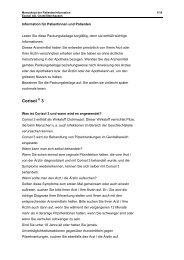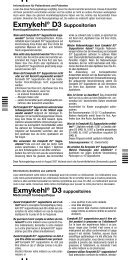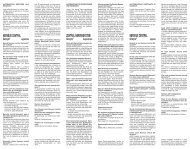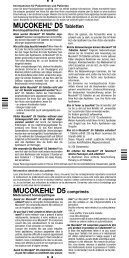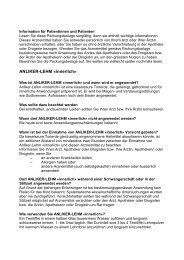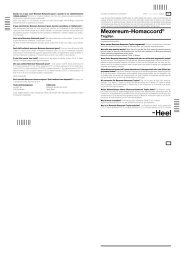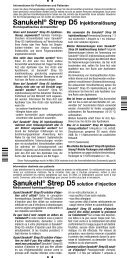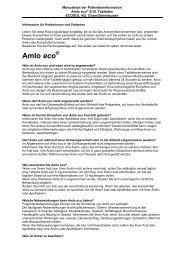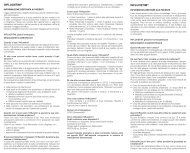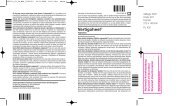Weleda Euphrasia-Augentropfen Collyre Euphrasia Weleda
Weleda Euphrasia-Augentropfen Collyre Euphrasia Weleda
Weleda Euphrasia-Augentropfen Collyre Euphrasia Weleda
You also want an ePaper? Increase the reach of your titles
YUMPU automatically turns print PDFs into web optimized ePapers that Google loves.
Information für Patientinnen und Patienten<br />
<strong>Weleda</strong> <strong>Euphrasia</strong>-<strong>Augentropfen</strong><br />
Anthroposophisches Arzneimittel<br />
Lesen Sie diese Packungsbeilage sorgfältig, denn sie enthält wichtige Informationen.<br />
Dieses Arzneimittel haben Sie entweder persönlich von Ihrem Arzt oder Ihrer Ärztin verschrieben erhalten<br />
oder Sie haben es ohne ärztliche Verschreibung in der Apotheke oder Drogerie bezogen. Wenden<br />
Sie das Arzneimittel gemäss Packungsbeilage bzw. nach Anweisung des Arztes, Apothekers oder<br />
Drogisten bzw. der Ärztin, Apothekerin oder Drogistin an, um den grössten Nutzen zu haben.<br />
Bewahren Sie die Packungsbeilage auf, Sie wollen sie vielleicht später nochmals lesen.<br />
Wann werden <strong>Weleda</strong> <strong>Euphrasia</strong>-<strong>Augentropfen</strong> angewendet?<br />
Gemäss der anthroposophischen Menschen- und Naturerkenntnis können <strong>Weleda</strong> <strong>Euphrasia</strong>-<strong>Augentropfen</strong><br />
bei Reizzuständen der Augenbindehaut wie geröteten, tränenden und müden Augen, bei<br />
Schwellungen des Lides sowie bei Fremdkörper- und Austrocknungsgefühl angewendet werden.<br />
<strong>Weleda</strong> <strong>Euphrasia</strong>-<strong>Augentropfen</strong> werden aus der ganzen, blühenden Pflanze Augentrost (<strong>Euphrasia</strong><br />
officinalis) hergestellt, welche seit Jahrhunderten als Heilpflanze zur Behandlung von gereizten Augen<br />
verwendet wird.<br />
Was sollte dazu beachtet werden?<br />
Wenn Ihnen Ihr Arzt oder Ihre Ärztin andere Arzneimittel verschrieben hat, fragen Sie Ihren Arzt, Apotheker<br />
oder Drogisten bzw. Ihre Ärztin, Apothekerin oder Drogistin, ob <strong>Weleda</strong> <strong>Euphrasia</strong>-<strong>Augentropfen</strong><br />
gleichzeitig angewendet werden dürfen.<br />
Wann dürfen <strong>Weleda</strong> <strong>Euphrasia</strong>-<strong>Augentropfen</strong> nicht oder nur mit Vorsicht angewendet<br />
werden?<br />
Wenn nach 2–3 Tagen keine Besserung eingetreten ist, ist ein Arzt, eine Ärztin aufzusuchen.<br />
Kommt es zu einer Verschlechterung oder treten neue Symptome auf, z.B. eine Abnahme der Sehschärfe,<br />
ist unverzüglich ein Arzt oder eine Ärztin aufzusuchen.<br />
Bei grünem Star (Glaukom) nicht ohne ärztliche Aufsicht anwenden.<br />
Informieren Sie Ihren Arzt, Apotheker oder Drogisten bzw. Ihre Ärztin, Apothekerin oder Drogistin,<br />
wenn Sie<br />
- an anderen Krankheiten leiden,<br />
- Allergien haben oder<br />
- andere Arzneimittel (auch selbstgekaufte!) einnehmen oder äusserlich anwenden.<br />
Wie verwenden Sie <strong>Weleda</strong> <strong>Euphrasia</strong>-<strong>Augentropfen</strong>?<br />
Falls vom Arzt bzw. von der Ärztin nicht anders verschrieben, werden <strong>Weleda</strong> <strong>Euphrasia</strong>-<strong>Augentropfen</strong><br />
wie folgt angewendet:<br />
Kinder und Erwachsene: 2mal täglich 1–2 Tropfen in den Bindehautsack einträufeln, am besten morgens<br />
und abends. Bei Bedarf auch 3mal täglich 1 Tropfen.<br />
Bei stark gereizten Augen maximal alle 2 Stunden 1 Tropfen.<br />
Säuglinge und Kleinkinder (bis 2 Jahre): 2 – 3mal täglich 1 Tropfen.<br />
Anwendung:<br />
1. Vor Gebrauch Flasche umdrehen und leicht schütteln (um Flüssigkeit in den Gummiteil zu bringen).<br />
2. Schutzkappe entfernen.<br />
3. Durch sanften Druck auf den Gummiteil Tropfen ins Auge träufeln.<br />
Halten Sie sich an die in der Packungsbeilage angegebene oder vom Arzt oder von der Ärztin verschriebene<br />
Dosierung. Wenn bei der Behandlung eines Kleinkindes/Kindes die gewünschte Besserung nicht<br />
eintritt, ist mit ihm ein Arzt bzw. eine Ärztin aufzusuchen.<br />
Wenn Sie glauben, das Arzneimittel wirke zu schwach oder zu stark, so sprechen Sie mit Ihrem Arzt,<br />
Apotheker oder Drogisten bzw. mit Ihrer Ärztin, Apothekerin oder Drogistin.<br />
Welche Nebenwirkungen können <strong>Weleda</strong> <strong>Euphrasia</strong>-<strong>Augentropfen</strong> haben?<br />
Selten tritt nach dem Einträufeln von <strong>Weleda</strong> <strong>Euphrasia</strong>-<strong>Augentropfen</strong> im Auge ein vorübergehendes<br />
Brennen auf.<br />
Wenn Sie Nebenwirkungen bemerken, die hier nicht beschrieben sind, sollten Sie Ihren Arzt,<br />
Apotheker oder Drogisten bzw. Ihre Ärztin, Apothekerin oder Drogistin informieren.<br />
Was ist ferner zu beachten?<br />
Nach Anbruch während maximal 4 Wochen weiter verwenden. <strong>Weleda</strong> <strong>Euphrasia</strong>-<strong>Augentropfen</strong> enthalten<br />
keine Konservierungsstoffe. Die Konservierung wird durch einen Silberring im Tropfer gewährleistet<br />
(oligodynamische Silberkonservierung).<br />
Hinweis für Kontaktlinsenträger/-innen: <strong>Weleda</strong> <strong>Euphrasia</strong>-<strong>Augentropfen</strong> sind mit den meisten handelsüblichen<br />
Kontaktlinsen (weiche und harte) verträglich. Kontaktlinsen sollten bei akut erkrankten<br />
Augen im Allgemeinen nicht getragen werden.<br />
Bewahren Sie das Arzneimittel ausserhalb der Reichweite von Kindern auf. Bei Raumtemperatur<br />
(15–25°C) sowie vor Feuchtigkeit geschützt lagern. Das Arzneimittel darf nur bis zu dem auf dem Behälter<br />
mit «EXP» bezeichneten Datum verwendet werden.<br />
Weitere Auskünfte erteilt Ihnen Ihr Arzt, Apotheker oder Drogist bzw. Ihre Ärztin, Apothekerin oder<br />
Drogistin.<br />
Was ist in <strong>Weleda</strong> <strong>Euphrasia</strong>-<strong>Augentropfen</strong> enthalten?<br />
1g Tropfflüssigkeit enthält: Augentrost D3 (ganze frische Pflanze) 1g.<br />
Hilfsstoffe: steriles Wasser, Kaliumnitrat, Borsäure, Natriumtetraborat, oligodynamische Silberkonservierung.<br />
Zulassungsnummer<br />
49‘537 (Swissmedic)<br />
Wo erhalten Sie <strong>Weleda</strong> <strong>Euphrasia</strong>-<strong>Augentropfen</strong>? Welche Packungen sind erhältlich?<br />
Erhältlich in Apotheken und Drogerien, ohne ärztliche Verschreibung.<br />
Tropfflasche à 10 ml.<br />
Auch als 20 Monodosen à 0,4ml erhältlich.<br />
Zulassungsinhaberin<br />
<strong>Weleda</strong> AG, Arlesheim, Schweiz<br />
Diese Packungsbeilage wurde im Juli 2007 letztmals durch die Arzneimittelbehörde (Swissmedic) geprüft.<br />
Information destinée aux patients<br />
<strong>Collyre</strong> <strong>Euphrasia</strong> <strong>Weleda</strong><br />
Médicament anthroposophique<br />
Lisez attentivement cette notice d’emballage. Vous y trouverez tous les renseignements importants<br />
concernant ce médicament.<br />
Ce médicament vous a été prescrit par votre médecin ou vous a été remis sans ordonnance par le<br />
pharmacien ou le droguiste. Pour en tirer le meilleur bénéfice, veuillez l’utiliser conformément à la<br />
notice d’emballage ou, le cas échéant, aux indications du médecin, du pharmacien ou du droguiste.<br />
Conservez cette notice d’emballage pour pouvoir la relire plus tard si nécessaire.<br />
Quand le <strong>Collyre</strong> <strong>Euphrasia</strong> <strong>Weleda</strong> est-il utilisé?<br />
Selon la connaissance anthroposophique de l’être humain et de la nature, le <strong>Collyre</strong> <strong>Euphrasia</strong> <strong>Weleda</strong><br />
peut être utilisé en cas d’irritation de la conjonctive tels que rougeur, larmoiement, fatigue oculaire ou<br />
gonflement de la paupière; en cas de sensation de la présence de corps étrangers et de dessèchement.<br />
Le <strong>Collyre</strong> <strong>Euphrasia</strong> <strong>Weleda</strong> est fabriqué à partir de la plante entière en fleurs de l’euphraise officinale<br />
(<strong>Euphrasia</strong> officinalis). Celle-ci est une plante médicinale appréciée depuis des siècles pour le<br />
traitement des irritations des yeux.<br />
De quoi faut-il tenir compte en dehors du traitement?<br />
Si votre médecin vous a prescrit d’autres médicaments, demandez à votre médecin, pharmacien ou<br />
droguiste si le <strong>Collyre</strong> <strong>Euphrasia</strong> <strong>Weleda</strong> peut être utilisé simultanément.<br />
Quand le <strong>Collyre</strong> <strong>Euphrasia</strong> <strong>Weleda</strong> ne doit-il pas être utilisé ou seulement avec<br />
précaution?<br />
Si aucune amélioration ne survient après 2 ou 3 jours, il faut consulter un médecin.<br />
En cas d’aggravation ou d’apparition de nouveaux symptômes, comme p.ex. une diminution de l’acuité<br />
visuelle, il faut immédiatement consulter un médecin.<br />
Si vous souffrez d’un glaucome, ne pas utiliser le produit sans avis médical.<br />
Veuillez informer votre médecin, votre pharmacien ou votre droguiste, si<br />
- vous souffrez d’une autre maladie,<br />
- vous êtes allergique ou<br />
- vous prenez déjà d’autres médicaments en usage interne ou externe (même en automédication!).<br />
Comment utiliser le <strong>Collyre</strong> <strong>Euphrasia</strong> <strong>Weleda</strong>?<br />
Sauf prescription contraire du médecin, utilisez le <strong>Collyre</strong> <strong>Euphrasia</strong> <strong>Weleda</strong> comme suit:<br />
Enfants et adultes: instiller 1–2 gouttes 2 fois par jour dans la poche conjonctivale, de préférence le<br />
matin et le soir. En cas de besoin, 1 goutte 3 fois par jour.<br />
Druckfarbe: Pantone 2747 U<br />
Format: 120 x 410mm
En cas d’irritation forte, au maximum 1 goutte toutes les 2 heures.<br />
Nourrissons et enfants (jusqu’à 2 ans): 1 goutte 2 à 3 fois par jour.<br />
Mode d‘emploi:<br />
1. Avant l‘emploi, tourner le flacon et agiter doucement (pour porter le liquide vers la partie<br />
caoutchoutée).<br />
2. Retirer le capuchon de protection.<br />
3. Par pression douce sur la partie caoutchoutée, instiller le collyre dans l’oeil.<br />
Veuillez vous conformer au dosage figurant sur la notice d’emballage ou prescrit par votre médecin. Si<br />
l’amélioration escomptée de l’enfant en bas âge/de l’enfant ne se produit pas, faites-le examiner par<br />
un médecin.<br />
Si vous estimez que l’efficacité du médicament est trop faible ou au contraire trop forte, veuillez vous<br />
adresser à votre médecin, pharmacien ou droguiste.<br />
Quels effets secondaires le <strong>Collyre</strong> <strong>Euphrasia</strong> <strong>Weleda</strong> peut-il provoquer?<br />
Dans de rares cas, des brûlures passagères peuvent être ressenties après instillation du <strong>Collyre</strong> <strong>Euphrasia</strong><br />
<strong>Weleda</strong>.<br />
Si vous remarquez d’autres effets secondaires non décrits ici, veuillez en informer votre médecin,<br />
pharmacien ou droguiste.<br />
A quoi faut-il encore faire attention?<br />
A utiliser dans les 4 semaines après ouverture du flacon. Le <strong>Collyre</strong> <strong>Euphrasia</strong> <strong>Weleda</strong> ne contient pas<br />
d’agents conservateurs. Le compte-gouttes est muni d’un anneau d’argent à effet conservateur oligodynamique<br />
pour garantir la conservation.<br />
Remarque pour les porteurs de lentilles de contact: le <strong>Collyre</strong> <strong>Euphrasia</strong> <strong>Weleda</strong> est compatible avec<br />
la plupart des lentilles de contact commercialisées (dures et souples). En général les lentilles de<br />
contact ne doivent pas être portés lors d’irritations aiguës de l’oeil.<br />
Conserver le médicament hors de la portée des enfants et à température ambiante (15–25°C) et à<br />
l’abri de l’humidité. Ce médicament ne doit pas être utilisé au-delà de la date figurant après la mention<br />
«EXP» sur le récipient.<br />
Pour de plus amples renseignements, consultez votre médecin, pharmacien ou droguiste.<br />
Que contient le <strong>Collyre</strong> <strong>Euphrasia</strong> <strong>Weleda</strong>?<br />
1g de liquide contient: Euphraise D3 (plante entière fraîche) 1g.<br />
Adjuvants: eau stérile, nitrate de potassium, acide borique, borax, conservation oligodynamique à<br />
l’argent.<br />
Numéro d’autorisation<br />
49’537 (Swissmedic)<br />
Où obtenez-vous le <strong>Collyre</strong> <strong>Euphrasia</strong> <strong>Weleda</strong>? Quels sont les emballages à disposition<br />
sur le marché?<br />
En vente en pharmacie et en droguerie, sans ordonnance médicale.<br />
Flacon compte-gouttes de 10ml.<br />
Disponible également sous forme de dosettes (monodose) de 20 x 0,4ml.<br />
Titulaire de l’autorisation<br />
<strong>Weleda</strong> SA, Arlesheim, Suisse<br />
Cette notice d’emballage a été vérifiée pour la dernière fois en juillet 2007 par l’autorité de contrôle<br />
des médicaments (Swissmedic).<br />
Informazione destinata ai pazienti<br />
Collirio <strong>Euphrasia</strong> <strong>Weleda</strong><br />
Medicamento antroposofico<br />
Legga attentamente il foglietto illustrativo che contiene importanti informazioni.<br />
Questo medicamento le è stato prescritto dal suo medico o le è stato consegnato senza prescrizione<br />
medica in farmacia o in drogheria. Per ottenere il maggior beneficio, usi il medicamento conformemente<br />
al foglietto illustrativo o segua le indicazioni del medico, farmacista o droghiere.<br />
Conservi il foglietto illustrativo per poterlo rileggere all’occorrenza.<br />
Quando si usa il Collirio <strong>Euphrasia</strong> <strong>Weleda</strong>?<br />
Secondo le conoscenze antroposofiche dell’uomo e della natura, il Collirio <strong>Euphrasia</strong> <strong>Weleda</strong> può essere<br />
impiegato in caso d’ irritazioni della congiuntiva quali arrossamento, lacrimazione e stanchezza<br />
dell’occhio o gonfiore dell palpebre; nei casi di sensazioni di presenza di corpi estranei e di secchezza<br />
corneale.<br />
Il Collirio <strong>Euphrasia</strong> <strong>Weleda</strong> viene elaborato dall’intera pianta in fiore dell’eufrasia (<strong>Euphrasia</strong> officinalis)<br />
che è usata da secoli come pianta medicinale per la cura degli occhi irritati.<br />
Di che cosa occorre inoltre tener conto durante il trattamento?<br />
Se il suo medico le ha prescritto altri medicamenti, chieda al suo medico, farmacista o droghiere se<br />
simultaneamente può applicare il Collirio <strong>Euphrasia</strong> <strong>Weleda</strong>.<br />
Quando non si può usare il Collirio <strong>Euphrasia</strong> <strong>Weleda</strong> e quando la sua somministrazione<br />
richiede prudenza?<br />
Se non si riscontrano miglioramenti entro 2–3 giorni, consultare il medico.<br />
Se il quadro clinico peggiora o compaiono nuovi sintomi, come per esempio il calo della vista, occorre<br />
rivolgersi immediatamente al medico.<br />
Non assumere senza controllo medico se si soffre di glaucoma.<br />
Informi il suo medico, farmacista o droghiere, nel caso in cui<br />
- soffre di altre malattie,<br />
- soffre di allergie o<br />
- assume o applica esternamente altri medicamenti (anche se acquistati di sua iniziativa!).<br />
Come usare il Collirio <strong>Euphrasia</strong> <strong>Weleda</strong>?<br />
Salvo diversa prescrizione medica impiegare il medicinale nel modo seguente:<br />
Bambini e adulti: instillare 1–2 gocce 2 volte al giorno nel sacco congiuntivale, meglio al mattino e alla<br />
sera. In alternativa e all’occorrenza, 1 goccia 3 volte al giorno.<br />
In caso d’irritazione forte, instillare 1 goccia a intervalli minimi di 2 ore.<br />
Lattanti e bambini (fino a 2 anni): 1 goccia 2, massimo 3 volte al giorno.<br />
Modalità d‘uso:<br />
1. Prima dell‘uso, capovolgere il flacone ed agitare leggermente (per far scendere il liquido nella<br />
pipetta di gomma).<br />
2. Togliere il tappo.<br />
3. Instillare le gocce nell’occhio premendo l’appositia pipetta di gomma.<br />
Si attenga alla posologia indicata nel foglietto illustrativo o prescritta dal medico. Se il trattamento del<br />
bambino piccolo/del bambino non porta al miglioramento desiderato, bisogna consultare un medico.<br />
Se ritiene che l’azione del medicamento sia troppo debole o troppo forte ne parli al suo medico, farmacista<br />
o droghiere.<br />
Quali effetti collaterali può avere il Collirio <strong>Euphrasia</strong> <strong>Weleda</strong>?<br />
In rari casi, dopo l’instillazione del Collirio <strong>Euphrasia</strong> <strong>Weleda</strong> si avverte un bruciore passeggero.<br />
Se osserva effetti collaterali qui non descritti, dovrebbe informare il suo medico, farmacista o<br />
droghiere.<br />
Di che altro occorre tener conto?<br />
Una volta aperto il flacone, usarlo per 4 settimane al massimo. Il Collirio <strong>Euphrasia</strong> <strong>Weleda</strong> non contiene<br />
conservanti. L’instillatore contiene un anello d’argento (ad effetto oligodinamico e conservante)<br />
per garantire la conservazione.<br />
Avviso particolare per i portatori di lenti a contatto: Il Collirio <strong>Euphrasia</strong> <strong>Weleda</strong> è compatibile con la<br />
maggioranza delle lenti a contatto disponibili sul mercato (dure e molli). In generale le lenti a contatto<br />
non devono essere portate nel periodo in cui l’occhio è acutamente irritato.<br />
Tenere il medicinale fuori dalla portata dei bambini. Conservare a temperatura ambiente (15–25°C) e<br />
protetto dall’umidità. Il medicamento non dev’essere utilizzato oltre la data indicata con «EXP» sul<br />
contenitore.<br />
Per ulteriori informazioni rivolgersi al medico, farmacista o droghiere.<br />
Cosa contiene il Collirio <strong>Euphrasia</strong> <strong>Weleda</strong>?<br />
1g di liquido contiene: Eufrasia D3 (pianta intera fresca) 1g.<br />
Adiuvanti: acqua sterile, potassio nitrato, acido borico, borace, conservante oligodinamico d’argento.<br />
Numero dell’omologazione<br />
49’537 (Swissmedic)<br />
Dov’è ottenibile il Collirio <strong>Euphrasia</strong> <strong>Weleda</strong>? Quali confezioni sono disponibili?<br />
In vendita in farmacia e in drogheria, senza prescrizione medica.<br />
Flaconi conta-gocce da 10ml.<br />
Ottenibile anche in confezioni a 20 monodose da 0,4ml.<br />
Titolare dell’omologazione<br />
<strong>Weleda</strong> SA, Arlesheim, Svizzera<br />
Questo foglietto illustrativo è stato controllato l’ultima volta nel luglio 2007 dall’autorità competente<br />
in materia di medicamenti (Swissmedic).<br />
Art-Nr.: 26 011 010<br />
Index 10





